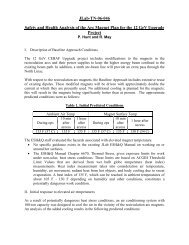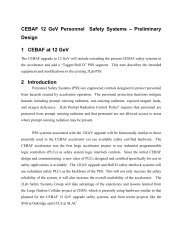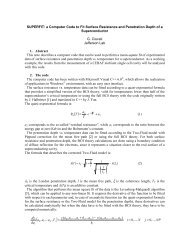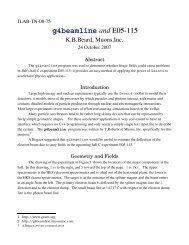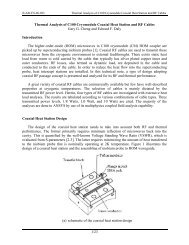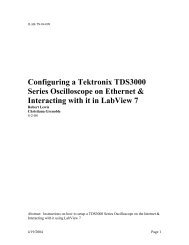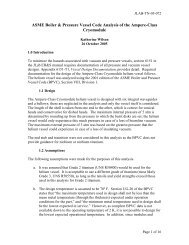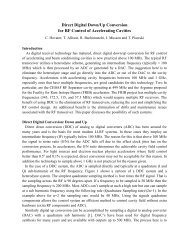Workshop on Polarized Electron Sources and Polarimeters
Workshop on Polarized Electron Sources and Polarimeters
Workshop on Polarized Electron Sources and Polarimeters
Create successful ePaper yourself
Turn your PDF publications into a flip-book with our unique Google optimized e-Paper software.
High Intensity <strong>Polarized</strong> Electr<strong>on</strong> Gun Studies<br />
at MIT-Bates<br />
E. Tsentalovich<br />
MIT-Bates Linear Accelerator Center, Middlet<strong>on</strong>, MA<br />
Abstract. A proposed new high-luminosity electr<strong>on</strong>-i<strong>on</strong> collider requires a polarized electr<strong>on</strong><br />
source of extremely high intensity. An i<strong>on</strong> back bombardment of the cathode is the main factor<br />
limiting the intensity of modern polarized electr<strong>on</strong> guns. This study examines the possibility of<br />
building a very high intensity polarized electr<strong>on</strong> gun.<br />
Keywords: <strong>Polarized</strong> electr<strong>on</strong> source, i<strong>on</strong> bombardment<br />
PACS: 29.25.Bx, 29.27.Hj<br />
INTRODUCTION<br />
Modern polarized electr<strong>on</strong> sources [1-6] routinely produce average current of<br />
hundreds of µA with a polarizati<strong>on</strong> approaching 90%. This intensity satisfies the<br />
requirements of the existing accelerator facilities. New advances in nuclear physics are<br />
expected with the development of a high luminosity electr<strong>on</strong>-i<strong>on</strong> collider (EIC). The<br />
c<strong>on</strong>cept of such a collider has been discussed in the nuclear physics communities<br />
around the world for the past decade. Several c<strong>on</strong>ceptual designs have been proposed.<br />
Brookhaven Nati<strong>on</strong>al Laboratory (BNL) develops two different versi<strong>on</strong>s of eRHIC<br />
[7], based <strong>on</strong> the existing Relativistic Heavy I<strong>on</strong> Collider (RHIC) complex. ELIC<br />
project [8] is developed at Thomas Jeffers<strong>on</strong> Nati<strong>on</strong>al Accelerator Facility (TJNAF).<br />
These EIC projects require a significantly higher intensity from a polarized electr<strong>on</strong><br />
source. The linac-ring versi<strong>on</strong> of eRHIC produces the most challenging requirements<br />
with an average current of up to 250 mA. MIT-Bates, in collaborati<strong>on</strong> with BNL, is<br />
investigating the possibility of building a very high intensity polarized electr<strong>on</strong> gun.<br />
MAJOR CHALLENGES<br />
Two main problems must be solved in order to build a polarized electr<strong>on</strong> gun with a<br />
very high average current. The first challenge is the heat load <strong>on</strong> the cathode. Tens or<br />
even hundreds of Watts of laser power must be deposited <strong>on</strong> a high polarizati<strong>on</strong><br />
(strained or superlattice) GaAs cathode in order to extract a current of hundreds of<br />
mA. Cathode holders in the existing guns can absorb less than 1W without<br />
temperature rise. Active cooling of the cathode is necessary to avoid overheating of<br />
the crystal. The cooling system must be compatible with the high voltage applied to<br />
the cathode <strong>and</strong> with UHV c<strong>on</strong>diti<strong>on</strong>s of the polarized electr<strong>on</strong> gun, <strong>and</strong> presents a<br />
formidable engineering challenge.



